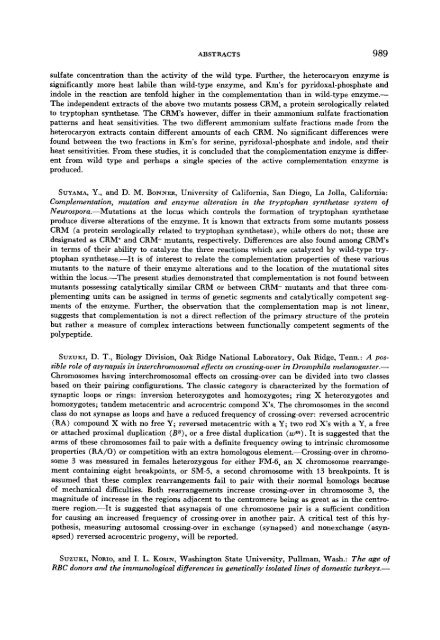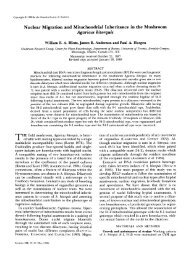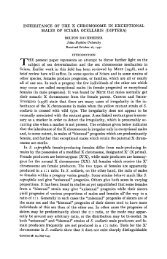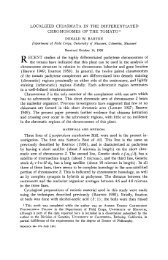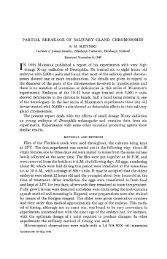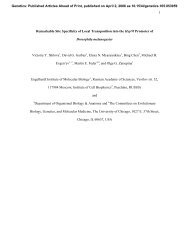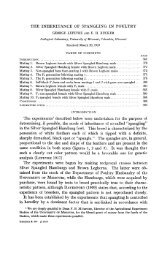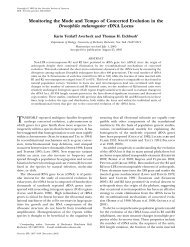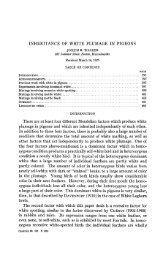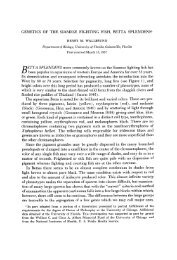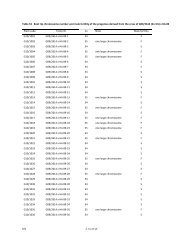abstracts of papers presented at the 1962 meetings - Genetics
abstracts of papers presented at the 1962 meetings - Genetics
abstracts of papers presented at the 1962 meetings - Genetics
Create successful ePaper yourself
Turn your PDF publications into a flip-book with our unique Google optimized e-Paper software.
ABSTRACTS 989<br />
sulf<strong>at</strong>e concentr<strong>at</strong>ion than <strong>the</strong> activity <strong>of</strong> <strong>the</strong> wild type. Fur<strong>the</strong>r, <strong>the</strong> heterocaryon enzyme is<br />
significantly more he<strong>at</strong> labile than wild-type enzyme, and Km’s for pyridoxal-phosph<strong>at</strong>e and<br />
indole in <strong>the</strong> reaction are tenfold higher in <strong>the</strong> complement<strong>at</strong>ion than in wild-type enzyme.-<br />
The independent extracts <strong>of</strong> <strong>the</strong> above two mutants possess CRM, a protein serologically rel<strong>at</strong>ed<br />
to tryptophan syn<strong>the</strong>tase. The CRM’s however, differ in <strong>the</strong>ir ammonium sulf<strong>at</strong>e fraction<strong>at</strong>ion<br />
p<strong>at</strong>terns and he<strong>at</strong> sensitivities. The two different ammonium sulf<strong>at</strong>e fractions made from <strong>the</strong><br />
heterocaryon extracts contain different amounts <strong>of</strong> each CRM. No significant differences were<br />
found between <strong>the</strong> two fractions in Km’s for serine, pyridoxal-phosph<strong>at</strong>e and indole, and <strong>the</strong>ir<br />
he<strong>at</strong> sensitivities. From <strong>the</strong>se studies, it is concluded th<strong>at</strong> <strong>the</strong> complement<strong>at</strong>ion enzyme is differ-<br />
ent from wild type and perhaps a single species <strong>of</strong> <strong>the</strong> active complement<strong>at</strong>ion enzyme is<br />
produced.<br />
SUYAMA, Y., and D. M. BONNER, University <strong>of</strong> California, San Diego, La Jolla, California:<br />
Complement<strong>at</strong>ion, mut<strong>at</strong>ion and enzyme alter<strong>at</strong>ion in <strong>the</strong> tryptophan syn<strong>the</strong>tase system <strong>of</strong><br />
Neurospora.-Mut<strong>at</strong>ions <strong>at</strong> <strong>the</strong> locus which controls <strong>the</strong> form<strong>at</strong>ion <strong>of</strong> tryptophan syn<strong>the</strong>tase<br />
produce diverse alter<strong>at</strong>ions <strong>of</strong> <strong>the</strong> enzyme. It is known th<strong>at</strong> extracts from some mutants possess<br />
CRM (a protein serologically rel<strong>at</strong>ed to tryptophan syn<strong>the</strong>tase), while o<strong>the</strong>rs do not; <strong>the</strong>se are<br />
design<strong>at</strong>ed as CRM’ and CRM- mutants, respectively. Differences are also found among CRM’s<br />
in terms <strong>of</strong> <strong>the</strong>ir ability to c<strong>at</strong>alyze <strong>the</strong> three reactions which are c<strong>at</strong>alyzed by wild-type tryptophan<br />
syn<strong>the</strong>tase.-It is <strong>of</strong> interest to rel<strong>at</strong>e <strong>the</strong> complement<strong>at</strong>ion properties <strong>of</strong> <strong>the</strong>se various<br />
mutants to <strong>the</strong> n<strong>at</strong>ure <strong>of</strong> <strong>the</strong>ir enzyme alter<strong>at</strong>ions and to <strong>the</strong> loc<strong>at</strong>ion <strong>of</strong> <strong>the</strong> mut<strong>at</strong>ional sites<br />
within <strong>the</strong> locus.-The present studies demonstr<strong>at</strong>ed th<strong>at</strong> complement<strong>at</strong>ion is not found between<br />
mutants possessing c<strong>at</strong>alytically similar CRM or between CRM- mutants and th<strong>at</strong> three complementing<br />
units can be assigned in terms <strong>of</strong> genetic segments and c<strong>at</strong>alytically competent segments<br />
<strong>of</strong> <strong>the</strong> enzyme. Fur<strong>the</strong>r, <strong>the</strong> observ<strong>at</strong>ion th<strong>at</strong> <strong>the</strong> complement<strong>at</strong>ion map is not linear,<br />
suggests th<strong>at</strong> complement<strong>at</strong>ion is not a direct reflection <strong>of</strong> <strong>the</strong> primary structure <strong>of</strong> <strong>the</strong> protein<br />
but r<strong>at</strong>her a measure <strong>of</strong> complex interactions between functionally competent segments <strong>of</strong> <strong>the</strong><br />
polypeptide.<br />
SUZUKI, D. T., Biology Division, Oak Ridge N<strong>at</strong>ional Labor<strong>at</strong>ory, Oak Ridge, Tenn.: A pos-<br />
sible role <strong>of</strong> asynapsis in interchromosomal effects on crossing-over in Drosophila me1anogaster.-<br />
Chromosomes having interchromosomal effects on crossing-over can be divided into two classes<br />
based on <strong>the</strong>ir pairing configur<strong>at</strong>ions. The classic c<strong>at</strong>egory is characterized by <strong>the</strong> form<strong>at</strong>ion <strong>of</strong><br />
synaptic loops or rings: inversion heterozygotes and homozygotes; ring X heterozygotes and<br />
homozygotes; tandem metacentric and acrocentric compond Xs. The chromosomes in <strong>the</strong> second<br />
class do not synapse as loops and have a reduced frequency <strong>of</strong> crossing-over: reversed acrocentric<br />
(RA) compound X with no free Y; reversed metacentric with a Y; two rod X’s with a Y, a free<br />
or <strong>at</strong>tached proximal duplic<strong>at</strong>ion (BS), or a free distal duplic<strong>at</strong>ion (@). It is suggested th<strong>at</strong> <strong>the</strong><br />
arms <strong>of</strong> <strong>the</strong>se chromosomes fail to pair with a definite frequency owing to intrinsic chromosome<br />
properties (RA/O) or competition with an extra homologous element.-Crossing-over in chromo-<br />
some 3 was measured in females heterozygous for ei<strong>the</strong>r FM-6, an X chromosome rearrange-<br />
ment containing eight breakpoints, or SM-5, a second chromosome with 13 breakpoints. It is<br />
assumed th<strong>at</strong> <strong>the</strong>se complex rearrangements fail to pair with <strong>the</strong>ir normal homologs because<br />
<strong>of</strong> mechanical difficulties. Both rearrangements increase crossing-over in chromosome 3, <strong>the</strong><br />
magnitude <strong>of</strong> increase in <strong>the</strong> regions adjacent to <strong>the</strong> centromere being as gre<strong>at</strong> as in <strong>the</strong> centro-<br />
mere region.-It is suggested th<strong>at</strong> asynapsis <strong>of</strong> one chromosome pair is a sufficient condition<br />
for causing an increased frequency <strong>of</strong> crossing-over in ano<strong>the</strong>r pair. A critical test <strong>of</strong> this hy-<br />
po<strong>the</strong>sis, measuring autosomal crossing-over in exchange (synapsed) and nonexchange (asyn-<br />
apsed) reversed acrocentric progeny, will be reported.<br />
SUZUKI, NORIO,<br />
and I. L. KOSIN, Washington St<strong>at</strong>e University, Pullman, Wash.: The age <strong>of</strong><br />
RBC donors and <strong>the</strong> immunological differences in genetically isol<strong>at</strong>ed lines <strong>of</strong> domestic turkeys.-


